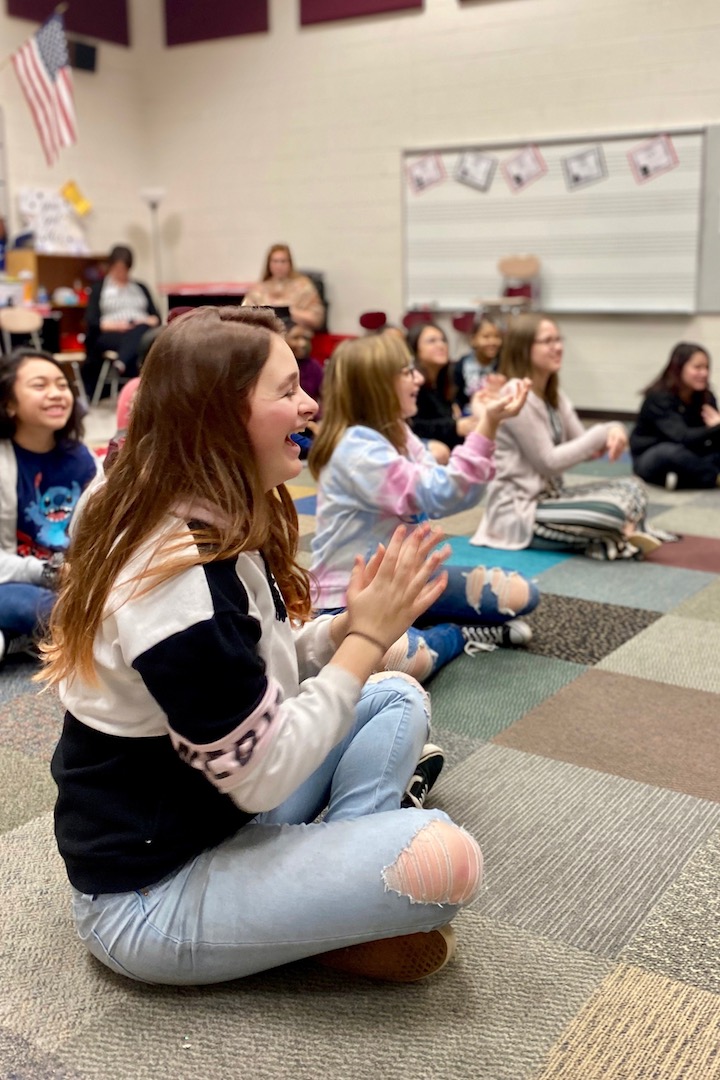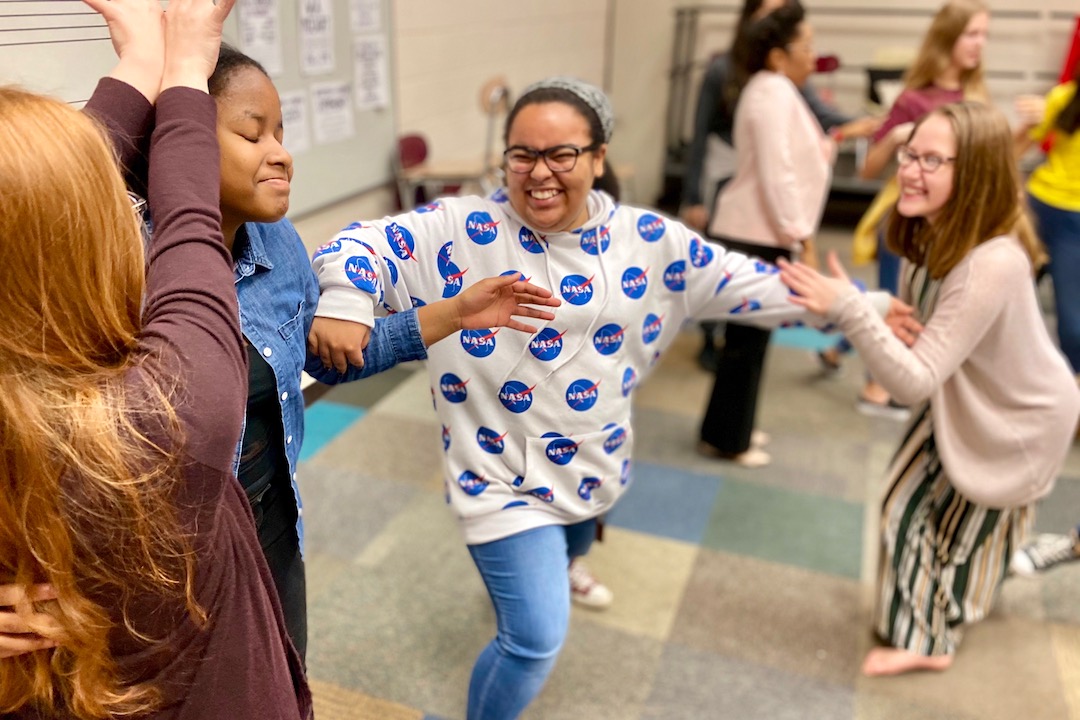CECA-CMCSS partnership boosting creativity in local schoolchildren
(Published Feb. 12, 2020)
John F. Kennedy Center for the Performing Arts teaching artist Cissy Whipp captured the attention of more than 20 West Creek Middle School students on Feb. 6.
“We are going to make a dance today together,” she told the seventh graders in Elizabeth Ward’s vocal music classroom. “The type of dance we’re doing is called creative dance where you are using your creativity to fulfill a task. It’s fueled by your imagination.”
By the end of the class, the students had created a dance – using a simple three-part choreography called ABA form – to represent a West African symbol for strength.
The exercise taught the students multiple lessons –West African textile art, symbolism and human self-expression – while asking them to focus on only one – dancing.
As a Kennedy Center teaching artist, Whipp travels the country showing educators how to use arts integration to enhance students’ K-12 education. She led 25 teachers in a three-hour Feb. 5 workshop before spending time in six of Ward’s classes, teaching nearly 200 students over two days.
“I love seeing creativity in children,” Whipp said. “There’s so much potential that you see, and I love that age of untapped potential. If you ask a child to do something, they’re going to do it, no hesitation, and I just love that energy.”
Austin Peay State University’s Center of Excellence for the Creative Arts (CECA) paid to fly in Whipp in collaboration with the Clarksville-Montgomery County School System as Kennedy Center Partners in Education. Whipp, who lives in Louisiana, is one of four teaching artists who will come to Clarksville this school year.
‘Looking at things a little differently’
Ward has integrated the techniques she learned from a prior teaching artist, Bomani Armah, who in October taught Kenwood Middle students how to use hip-hop to write.
“It was a really great way to integrate the arts with English language arts,” Ward said. “A lot of times, our kids don’t realize that lyrics are really poetry, and it’s a great way to introduce them to writing.
“You don’t walk into choir and think, ‘I’m going to learn English in here today,’” she added.
The students, maybe more than anything, have enjoyed the freedom the creative process has given them.
“They realize every thought is an important thought that can be turned into something else,” Ward said. “They come to the understanding that when you’re being creative, it might not work out the way you thought it should, but sometimes those bits and pieces come back later.”
Though at first reluctant, the students are laughing and sharing by the end of the class.
“They’re telling their friends about it, ‘This is what we did in choir,’” Ward said. “They’re looking at something a little differently and having a different creative outlet, and they’ll say, ‘You know, Ms. Ward, that was really fun!’”
Everyone learns by doing

All Whipp had to do to teach West Creek Middle students about textile art and symbolism was to get them moving.
“All of this movement is based on symbols like that symbol up there for strength, these are called adinkra,” she told the class. Adinkra are stamped art from West Africa, particularly Ghana.
Whipp asked the students to create a dance to represent the adinkra symbol of strength – rams’ horns.
She moved around the room helping the students, “Did you see the upper swirl, the diamond and the lower swirl? Yeah, good job!”
Whipp explained how the process works: “I believe that everyone learns by doing. Engaging in the choreography process gives students the opportunity to analyze and synthesize material.”
The process also gives them pride in their creativity.
“It’s this feeling that they can do this, that feeling of success, they are using their creations, they feel empowered,” Whipp said.
The partnership continues
CECA is planning two more Kennedy Center teaching artist visits, which excites Ward.
“I’ve really enjoyed the Kennedy Center of the Arts partnering with Clarksville-Montgomery County,” she said. “It’s always great as a teacher to have something else in your pocket that you can pull out and stretch your students in a different way.
“It’s another way to catch their attention and show them that these skills that we’re trying to teach you, they’re reflective, and they’re used across many different things.”
The teaching artist residencies are supported by CECA and the Heydel Family Foundation, which gave a generous 10-year gift to Austin Peay in honor of June Heydel. The CECA-CMCSS partnership also is supported by a grant from the National Endowment of the Arts.
To learn more
- To support CECA and other APSU fundraising initiatives, call the Office of University Advancement at 931-221-7127.
- For more about CECA, go to apsu.edu/ceca.
- For more about the Kennedy Center for the Performing Arts’ Partners in Education Program, visit kennedy-center.org/partners.
- For more about Cissy Whipp, visit https://cissywhipp.com.
News Feed
View All NewsNo items to display

